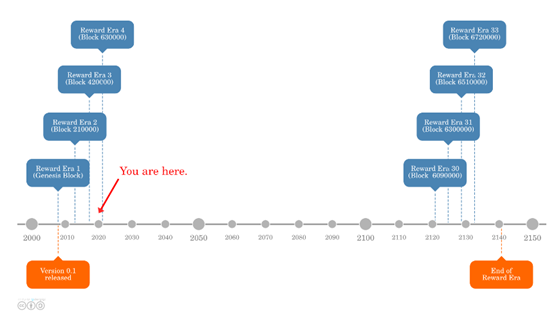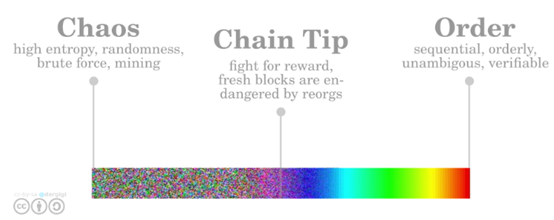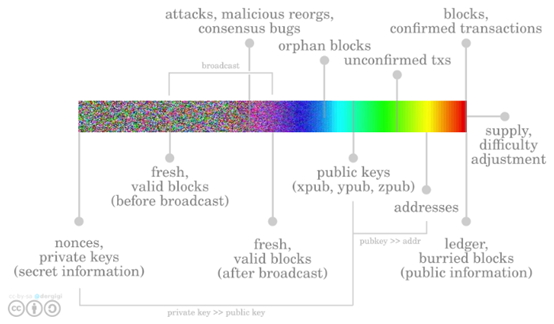Bitcoin's eternal battle: fighting entropy, rising on the borders of order and chaos
Source: The Bitcoin Times
Compilation: First Class
How does Bitcoin prosper on the edge between order and chaos? This article takes you to understand why the Bitcoin network embodies the eternal battle of life, the fight against entropy, a battle on the edge of order and chaos.

- Perfecting Blockchain Cognition with Bitcoin's Middle Tier Knowledge
- Dry goods | Three technical analysis methods to play the Bitcoin market cycle
- Babbitt Column | Regulatory Sandbox Confirms Difficulties in Implementation, China Should Actively Deploy Industrial Sandbox
Bitcoin is operating normally, no matter what you think of it, there is no doubt that it is really working, constantly developing, and living. Even though most countries in the world are in stagnation, the Bitcoin network produces a block every 10 minutes as usual.
There are many reasons why Bitcoin operates: game theory, economic incentives, cryptography, perfect engineering, and a resilient network layer. Killing Bitcoin is very difficult. Defeating Bitcoin is like stifling an idea that resides in the hearts of millions of enthusiasts.
First, it is very difficult to shut down the Internet globally; second, Bitcoin can surpass the Internet. Any device capable of transmitting data can be used to transmit Bitcoin transactions. Bitcoin is just a ledger, all the data above is just information. It is puzzling why the Bitcoin network embodies the eternal battle of life, the fight against entropy, a battle on the edge of order and chaos.
To understand this chaotic battle and how Bitcoin thrives because of the struggle, a brief discussion of the concepts of entropy, randomness, and information can help you understand. These concepts are relevant and they play a very important role in Bitcoin's struggle for survival.
entropy
In calculations, entropy can be used to measure the randomness of a data source. Generally speaking, in cryptography, especially in Bitcoin, a good source of entropy can guarantee security. If the entropy of the personal private key (that is, the seed phrase) becomes chaotic, your bitcoin will soon become my bitcoin.
Entropy is a more complex concept. In general, it describes the randomness or compressibility of an object.
· High entropy: randomness
· Low entropy: regular
Or in the words of Tsachy Weissman:
· High entropy: incompressible
· Low entropy: can be quite compressed
Entropy has complex formulas and many clear definitions. This concept has applications in the fields of classical thermodynamics, statistical thermodynamics, quantum statistical physics, ordered and disordered, life, astrophysics. It is also a measure of irreversibility.
In Bitcoin, there is a certain probability of reversibility and irreversibility. If a sufficient number of people have considerable hash power, transactions can be reversed. Bitcoin is not absolutely irreversible, and the final settlement transaction is not necessarily final. There is a certain probability that it can be reversed. The possibility of reversal may exceed astronomical numbers (meaning that the probability of reversal is extremely low), but there is no final settlement and neither does Bitcoin. Nakamoto consensus prohibits reversal transactions.
"The first law of thermodynamics, also known as the law of conservation of energy, states that energy cannot be produced or destroyed in an isolated system. The second law states that the entropy of any isolated system is always increasing, and the third law states that when temperature approaches absolute At zero degrees, the entropy of the system is close to a constant value. "
— Knut Svanholm
In Bitcoin, entropy is important because:
1. Secret information should be generated by a high-entropy data source
2. The new block reverses entropy locally, creating order from chaos
3.Bitcoin's security model relies on chaotic processes
4. Verification relies on a deterministic process
5. Everyone can validate structured data
6. No one can guess random data
The above six are absolutely for everyone, but the truth is slightly different: Since Bitcoin is inherently probabilistic, in theory, one can guess a private key, just like in theory you can Find 1 billion valid blocks in one millisecond.
Aside from the tedious details, let's start with the simple ones. Generally, if you have two coins, the entropy of this system is 2. For example: you can use two bits to describe the entire system: 00, 01, 10, 11.

2-bit entropy
Toss two coins at the same time, and you will get either reverse, anyway, positive and negative, and positive. If you toss the coins evenly, the probability of each combination is 25%. Imagine if a system could throw hundreds of coins at the same time, then you have a system that can be used to generate private keys.
Randomness
Randomness is the foundation of cryptography. The foundation of all secret communications is some form of information asymmetry: knowing something that a potential eavesdropper doesn't know.
An absolute secret is like an absolutely secret password: it is randomly generated, that is, the password comes from a high-entropy data source.

Random noise, can you tell how much information this picture contains?
If a piece of information is "fully" encrypted, eavesdroppers cannot distinguish what is said from random data. This is what proper encryption does: you want to hide what is being said, if possible, or even something important.
"Good" randomness: incompressible / high entropy / secret / secure.
"Bad" randomness: compressible / low entropy / guessable / unsafe.
Bitcoin itself does not use encryption. The design of the entire ledger is open and transparent, and anyone can audit the system. Bitcoin uses cryptographic signatures and cryptographic hashing techniques, both of which produce quasi-random results. If you know the key, you can unlock some tokens (using the key), add new blocks to the blockchain (using a random number you find), or prove your identity (by signing a message, at least proving that you control one Or multiple keys).
Only you know your private key, and only successful miners can find the random number of the next block. This is information asymmetry, and it is how Bitcoin works.
All cryptosystems work because of asymmetric information. The puzzling thing is that properly encrypted data is no different from random data. Otherwise, eavesdroppers may recognize encrypted messages, which in turn may prove that the encryption technology used is not perfect.
information
What exactly is information?
It is often said that Bitcoin has thermodynamic security. Although this is true, go a little deeper. What does thermodynamic stability mean?
It means that, as far as is known, changing things in the universe requires energy. "Changing things" refers to changing anything in the universe. It requires "using" energy and putting in some work to complete the change.
Move a chair? You have to pay some work. Planting a tree? You need to use sunlight to convert CO2 into wood. It takes energy to manipulate any device that holds data. Store results? No matter what medium you use, you need energy to manage (and protect) atoms to store results.
Bitcoin mainly lives in the field of information, and like all other information systems, it needs to store and process information through a physical medium. So if you change the information in Bitcoin, you actually change one thing in the real world. It doesn't matter whether it's a solid state drive, a USB flash drive, a hard drive, an optical storage medium, or anything else.
Changing things, that is flipping bits, requires energy, which is the fundamental problem of all calculations. This is why if a computer does a lot of "thinking", it will emit a lot of noise and heat. Computer science students must learn Big O notation, and software companies especially like to ask questions about it. Changing 0 to 1 requires work, no matter how fast you work, you still need to consume some energy. According to the law of conservation of energy in physics, flipping bits is work and consumes energy.
Bitcoin makes use of it a bit, and there is a big difference between problems that are difficult to calculate and problems that are exponentially difficult to calculate.
Back to the original question: what exactly is information?

Sorted colors. How much information does this picture contain?
Information involves knowledge and meaning and is the opposite of the unknown, while the opposite of the information in the data is randomness. In other words, if you can't understand some data, then the data is random to you.
Machine-readable information: compressible.
· Meaningless information: incompressible.
Borrowing π may explain this: π = 3.141592653589793 … can be "compressed" into π, or the circumference and diameter of a circle.
If you are a computer programmer, think like this: Can I write a computer program to generate the message I want to convey? (This is what I mean by "compressible.")
In short: machine-readable and meaningless information, order and chaos, information and randomness are intricately linked. It can be said that they are both sides of the same coin, and the two concepts are linked by entropy.
Information equals structure, which benefits from redundancy. The oldest structure in nature has adapted to survive through evolution. The root of this structure is DNA, and the double strands are entangled with each other to form a double helix. The symmetrical and redundant information allows the characteristics of DNA survival and reproduction to be embedded in the evolution of DNA: The replication mechanism of DNA relies on this redundant structure. Due to error correction, four bases are required instead of two. Bases.
In contrast, Bitcoin is simple: one chain, two bits, no error correction (information is perfectly copied). Like DNA, Bitcoin's survival (and booming) characteristics are embedded in the replication process: a chaotic race to find new blocks begins, copy blocks on the network, and copy software on as many nodes as possible ( And ledger). When we talk about Bitcoin, fixing bugs is equivalent to it still alive. The Bitcoin network heartbeats every 10 minutes for self-verification. This is why Bitcoin is extremely powerful, it is designed to survive.
In Bitcoin, high-entropy information is usually kept secret. As the name implies, the private key is guaranteed to be private and only visible to individuals. The random number you just calculated also represents the amount of work you do when digging out new blocks, which is usually kept private. You don't want your opponent to know which random numbers generate invalid blocks, so skip these random number calculations.

The left represents chaos, and the right represents order.
Bitcoin uses order and chaos to create a system that grows and even prospers between these two extremes. It uses information asymmetry and an ingenious incentive structure to launch a global competition to find the secrets of Bitcoin.
So which processes are orderly and which are chaotic? How can Bitcoin grow on the edge of order and chaos? Take a look below.
Hovering between order and chaos
What is driving the Bitcoin network? The answer may be more than one. What really drives the Bitcoin network is the global clock: block clocks, each block is a unit of time.
At present, we call the block production process mining, because every valid block mined will generate a new bitcoin. These bitcoins are called "block rewards", which is an incentive to guide the development of the network. mechanism.
In a sense, Bitcoin "grows" between order and chaos: finding new blocks is a chaotic process, and the result is a very ordered list of transactions: the Bitcoin blockchain, also known as the ledger .
From the perspective of "looking for new blocks", it is still in the very early stage, and it has only been produced for 10 years, and the block reward will continue to around 2140, which means that we have entered the 13% bitcoin startup stage: the reward era.
Satoshi Nakamoto no doubt knows that Bitcoin is a long game. The production of bitcoin rewards in new blocks is just one stage of a bitcoin game. The entire Bitcoin has 6,930,000 blocks. Based on the average block production time of 10 minutes, the reward period can reach 131 years.

2019: the early stages of the Bitcoin reward phase
There will always be a day when the miner's income will come mainly from the network toll market, as Dan Held elaborated in his book "Bitcoin's Security is Fine" That way, at some point between 2020 and 2140, either Internet fees would take over the market, or Bitcoin would die, or some museum computers would look for new blocks without loss.
After 2140, bitcoin "mining" may still be talked about, and even then miners will not produce new bitcoins anymore. 21 million bitcoins, about 2,099,999,997,690,000 Satoshi, will all be mined. The existing token pool no longer adds new Bitcoins into circulation.
Miners will still struggle to find new blocks, but these new blocks will have a lengthy transaction history. Gone are the days when miners rewarded themselves with new bitcoins in coinbase transactions and spent those bitcoins after 100 blocks.
Will Bitcoin survive 5,000 years? Will it eventually replace gold as human de facto currency? No way of knowing, but important information is difficult to erase. Bitcoin is expected to survive for a long time, just like ancient scriptures and religious books. It just conveys information that goes beyond the life cycle of print media.
Of course, I expect something similar to hyperbitcoinization (bitcoin leading to cash suspension) before this happens. There will be a cyclical Bitcoin economy, where Bitcoin banks settle huge transactions globally. Ordinary citizens, or people with monetary sovereignty, the basic layer of Bitcoin will be used by people like you and me.
Knowing the concepts of Bitcoin's development stage, order, information, randomness, and entropy, let's look at some concepts of Bitcoin. Visual distinction: from chaos (left) to order (right).

Bitcoin evolves between order and chaos.
Although there is a certain framework for order and chaos, it is neither precise nor universally applicable. The core of Bitcoin is to survive, develop, and prosper between order and chaos.

Consider the following concepts:
· Private key: chaotic information with extremely high randomness. Completely secret information, the highest entropy means the highest security. If the private key is not delivered randomly, security is questionable.
· Random number: chaotic information with high randomness. A random number is a specific number. Miners are in constant competition to find the next random number that can produce a valid block. There may be multiple random numbers that meet the standard, but the entire mining process looks for only one random number.
· New block (before broadcast): The newly discovered block is the result of a chaotic process. Blocks before broadcasting can be understood as secret information. The new block is uncertain, and multiple blocks may be aggregated to the front end of the blockchain at the same time. The best option is to broadcast new blocks to everyone immediately to get rewards. If you are an attacker, you will block block broadcasts.
· Chain end: The chain end is also an orderly state that is produced through a chaotic process. The end of the chain may be uncertain. A version of the end of the chain survives, and the failed end of the chain becomes an orphan. All the information gathered at the end of the chain can be verified, and the end of the chain reflects the current time of Bitcoin.
Solitary blocks: Solitary blocks belong to a natural ordering process in the Bitcoin blockchain.
Some valid blocks are usually discarded. If two valid blocks are found at almost the same time, a probabilistic life-and-death battle will begin. Over time, only one block will win, and the failed block becomes an lone block.
· Unconfirmed transactions: an orderly structure that is easier to verify. Unconfirmed transactions may be valid or invalid. Through economic incentives, miners are encouraged to pack effective transactions into blocks. Packaging blocks is a probabilistic, market-driven process. Invalid transactions will be discarded.
Submerged block: An ordered structure that was once produced by a chaotic process. The possibility of reorganizing buried blocks has increased exponentially. For example: if each block has a 50% probability of reorganization, the probability of reorganizing 6 blocks is 1.5%. The actual probability of each block is close to 0.31%, and the actual probability of 6 blocks is close to 0.0000000000008875%.
Confirmed transactions: an orderly structure that is easy to verify. There is a certain probability of irreversibility, which depends on the height of the block. Once a transaction is confirmed, the deeper it is buried in the blockchain, the less likely it is to be reversed.
Public key: The extended public key (xpub, ypub, zpub) is generated by a random seed (private key).
Block production time: The Bitcoin network finds valid blocks on average every 10 minutes. When Bitcoin's heartbeat is in units of blocks, it is very regular. Although it is also measured by human time, mining is a process of finding probability, and it may find blocks sooner or later.
Difficulty adjustment: Although the difficulty adjustment is an extremely orderly process, if the hashing power changes drastically, it may become chaotic (just like the controversial bcash hard fork in August 2017). The difficulty adjustment is based on the block time, which is only probabilistically close to human time.
Bitcoin supply: Since the birth of Bitcoin, it has stipulated the total supply of Bitcoin. The new Bitcoin issuance is embedded in Bitcoin's consensus code and is almost impossible to change.
· The entire ledger, which is a deeply buried block (also known as the Bitcoin blockchain): is an orderly, continuous, and very clear structure on the chain end, and everyone can verify it.
· Ledger verification: Verification is an orderly and continuous process. The result of the verification is a simple Boolean value for each block: whether this value is correct and valid. Each node independently reached the same block height, reaching Satoshi consensus.
All of the above mechanisms answer the question "Is this a real event?" With "yes" or "no".
The role of the entire Bitcoin blockchain is to decide what happened when to whom. How much money does everyone have? How to get money? In any way, everyone can audit transactions and get consistent results.
In short, Bitcoin uses chaotic processes (mining, private key generation) and information asymmetry (widely shared public information, completely private secret information) to build a structured, orderly, and permanent record for everyone. Records can be audited and verified.
This is Bitcoin, this is the Satoshi Nakamoto consensus, this is innovation, and this is why Bitcoin has become the most perfect and powerful currency on earth.
You can call Bitcoin open source, license-free, borderless, neutral, anti-censorship, open, complete, anti-fragile, and more.
I call it life, we all call it Bitcoin.
Reprinted please retain copyright information.
We will continue to update Blocking; if you have any questions or suggestions, please contact us!
Was this article helpful?
93 out of 132 found this helpful
Related articles
- Will the date of CME's launch of Bitcoin options be the end of altcoins?
- Analysis of Singapore's Payment Services Act: What is the difference between the regulatory policies imposed on different types of digital currencies
- EOSIO 2.0 is officially released, solving the biggest bottleneck of blockchain development, making EOS "faster, easier and more secure"
- 2020 Investor's Congress discussion: Market fluctuations, how to predict capital?
- IDC report: Blockchain + AI will be the world of Chinese enterprises?
- 10 indicators show why BTC is successful
- How to start a blockchain fairly or unfairly?





